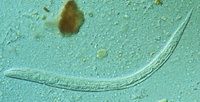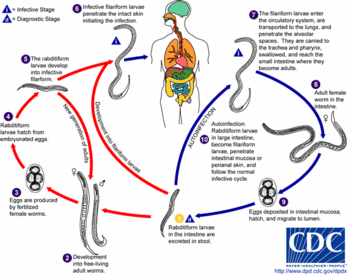Parasitic infection with nematodes is typically more of a nuisance disease than a serious medical condition, as many family physicians who have treated pinworm infections can attest. However, one nematode has the unique ability to complete its replication cycle entirely within a human host, and this ability can lead to so-called "hyperinfection" in immunocompromised persons. Almost all of the fatal cases of helminthic infection in the United States are caused by this autoinfecting nematode, Strongyloides. Siddiqui and Berk review the epidemiology, clinical presentation, and treatment of strongyloidiasis.
Most strongyloidiasis infections in the United States are caused by Strongyloides stercoralis. The most endemic areas of the globe are southeast Asia, Latin America, and sub-Saharan Africa, but there are pockets of infection in southeastern United States. Chronic infection with S. stercoralis is often inapparent, but it can cause gastrointestinal, cutaneous, or pulmonary symptoms. The most common gastrointestinal problems are diarrhea and abdominal bloating. Cutaneous infection typically involves the perianal area with a migratory, serpiginous rash that can spread to the buttocks, groin, or trunk. Cough and shortness of breath may herald pulmonary involvement.
The most common way to identify the infection is to detect the nematode in stool samples. However, this may be difficult because the intestinal worm load is low without hyperinfection, and a single stool sample is falsely negative in up to 70 percent of patients. Serologic tests are complicated by cross-reactivity with numerous other helminthic infections. Guaiac-positive stools and eosinophilia are common but nonspecific for infection.
Hyperinfection only occurs in those who are immunocompromised, usually through chronic steroid use, chemotherapy, or infection with human immunodeficiency virus. The authors note that it may be prudent to look for occult strongyloidiasis in high-risk patients if immunosuppression is anticipated in the future (i.e., long-term corticosteroid use), because the fatality rates in patients with hyperinfection have been as high as 87 percent.
Thiabendazole has been the most commonly used anthelmintic for strongyloidiasis, but more recent studies have shown ivermectin to be better tolerated, with a higher cure rate. Complete eradication of the helminth is necessary to prevent serious disease. Multiple stool samples collected on different days should be examined to ensure eradication, given the high false-negative rate with single samples.
COPYRIGHT 2002 American Academy of Family Physicians
COPYRIGHT 2002 Gale Group



